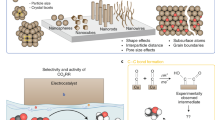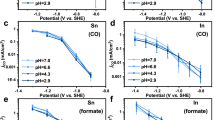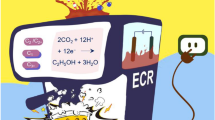Abstract
Electrochemical reduction of carbon dioxide (CO2) is promising to alleviate carbon emissions and produce fuels and materials in a circular way, yet effective tuning strategies and fundamental understanding are lacking. In particular, cell design is actually done by simplistic one- or two-dimensional models, which incorporate numerous assumptions, leading to potential errors and discrepancies. Here, we establish new two-dimensional multiphysics models that incorporate cell-specific geometry, gas–liquid two-phase flow, and electrochemical kinetics. We calculate the temporary and spatial variations of the local CO2 concentration, electrochemical parameters, and products selectivity on the cathode surface, under different cell configurations and operating parameters. Products include dihydrogen (H2), carbon monoxide (CO), formic acid (HCOOH), ethylene (C2H4), ethanol (C2H5OH), and propanol (C3H7OH). We further investigated the effect of local CO2 concentration on CO2 reduction performance. We find that high local CO2 concentration, above 8.7 mM, enhances the selectivity for C1 products and the cathode polarization, whereas extremely low local CO2 concentration, of 0.75–5.5 mM, favors the selectivity for C2+ products, especially alcohols. C2+ selectivity ranges from 81.3 to 88.6% at 4.8–5.5 mM local CO2 concentration, while alcohol products selectivity ranges between 54.9 and 65.4% at 0.75–1.9 mM CO2 concentration. These findings are attributed to the reduced CO2 diffusion layer thickness to less than 10 μm at the cathode. This enhances the CO2 mass transfer efficiency to the cathode, and eliminates temporal and spatial variations of the local CO2 distribution along the cathode surface.




Similar content being viewed by others
References
Monroe MM, Lobaccaro P, Lum Y et al (2017) Membraneless laminar flow cell for electrocatalytic CO2 reduction with liquid product separation. J Phys d: Appl Phys 50(15):154006. https://doi.org/10.1088/1361-6463/aa6359
Bai S, Qiu H, Song M et al (2022) Porous fixed-bed photoreactor for boosting C–C coupling in photocatalytic CO2 reduction. Science 2(4):428–437. https://doi.org/10.1016/j.esci.2022.06.006
Boehme A, Bui J, Fenwick AQ et al (2023) Direct observation of the local microenvironment in inhomogeneous CO2 reduction gas diffusion electrodes via versatile pOH imaging. Energy Environ Sci. https://doi.org/10.1039/d2ee02607d
Bui JC, Lees EW, Pant LM et al (2022) Continuum modeling of porous electrodes for electrochemical synthesis. Chem Rev 122(12):11022–11084. https://doi.org/10.1021/acs.chemrev.1c00901
Bui JC, Kim C, Weber AZ et al (2021) Dynamic boundary layer simulation of pulsed CO2 electrolysis on a copper catalyst. ACS Energy Letter 6(4):1181–1188. https://doi.org/10.1021/acsenergylett.1c00364
Burdyny T, Smith WA (2019) CO2 reduction on gas-diffusion electrodes and why catalytic performance must be assessed at commercially-relevant conditions. Energy Environ Sci. https://doi.org/10.1039/C8EE03134G
Corral D, Lee DU, Ehlinger VM et al (2022) Bridging knowledge gaps in liquid-and vapor-fed CO2 electrolysis through active electrode area. Chem Catalysis 2(11):3239–3253. https://doi.org/10.1016/j.checat.2022.09.017
Deng B, Huang M, Zhao X et al (2021) Interfacial electrolyte effects on electrocatalytic CO2 reduction. ACS Catal 12(1):331–362. https://doi.org/10.1021/acscatal.1c03501
Dinh C-T, Burdyny T, Kibria MG et al (2018) CO2 electroreduction to ethylene via hydroxide-mediated copper catalysis at an abrupt interface. Science 360(6390):783–787. https://doi.org/10.1126/science.aas9100
Fan WK, Tahir M (2022) Recent advances on cobalt metal organic frameworks (MOFs) for photocatalytic CO2 reduction to renewable energy and fuels: a review on current progress and future directions. Energy Convers Manage 253:115180. https://doi.org/10.1016/j.enconman.2021.115180
Fu J, Liu K, Li H et al (2022) Bimetallic atomic site catalysts for CO2 reduction reactions: a review. Environ Chem Lett 20(1):243–262. https://doi.org/10.1007/s10311-021-01335-3
Gabardo CM, O’Brien CP, Edwards JP et al (2019) Continuous carbon dioxide electroreduction to concentrated multi-carbon products using a membrane electrode assembly. Joule. https://doi.org/10.1016/j.joule.2019.07.021
García de Arquer FP, Dinh C-T, Ozden A et al (2020) CO2 electrolysis to multicarbon products at activities greater than 1 A cm−2. Science 367(6478):661–666. https://doi.org/10.1126/science.aay4217
Hasija V, Kumar A, Sudhaik A et al (2021) Step-scheme heterojunction photocatalysts for solar energy, water splitting, CO2 conversion, and bacterial inactivation: a review. Environ Chem Lett 19(4):2941–2966. https://doi.org/10.1007/s10311-021-01231-w
Henckel DA, Counihan MJ, Holmes HE et al (2020) Potential dependence of the local pH in a CO2 reduction electrolyzer. ACS Catal 11(1):255–263. https://doi.org/10.1021/acscatal.0c04297
Higgins D, Hahn C, Xiang C et al (2018) Gas-diffusion electrodes for carbon dioxide reduction: a new paradigm. ACS Energy Lett 4(1):317–324. https://doi.org/10.1021/acsenergylett.8b02035
Kas R, Star AG, Yang K et al (2021) Along the channel gradients impact on the spatioactivity of gas diffusion electrodes at high conversions during CO2 electroreduction. ACS Sustain Chem Eng 9(3):1286–1296. https://doi.org/10.1021/acssuschemeng.0c07694
Kong S, Lv X, Wang X et al (2023) Delocalization state-induced selective bond breaking for efficient methanol electrosynthesis from CO2. Nat Catal 6(1):6–15. https://doi.org/10.1038/s41929-022-00887-z
Kuhl KP, Cave ER, Abram DN et al (2012) New insights into the electrochemical reduction of carbon dioxide on metallic copper surfaces. Energy Environ Sci 5(5):7050–7059. https://doi.org/10.1039/c2ee21234j
Li J, Li F, Liu C et al (2022) Polyquinone modification promotes CO2 activation and conversion to C2+ products over copper electrode. ACS Energy Lett 7(11):4045–4051. https://doi.org/10.1021/acsenergylett.2c01955
Liu Y, Bai S, Wang F et al (2022a) Photoelectrochemical technology for solar fuel generation, from single photoelectrodes to unassisted cells: a review. Environ Chem Lett 20(2):1169–1192. https://doi.org/10.1007/s10311-021-01364-y
Liu Y, Wang F, Jiao Z et al (2022b) Photochemical systems for solar-to-fuel production. Electrochem Energy Rev. https://doi.org/10.1007/s41918-022-00132-y
Nesbitt NT, Burdyny T, Simonson H et al (2020) Liquid–solid boundaries dominate activity of CO2 reduction on gas-diffusion electrodes. ACS Catal 10(23):14093–14106. https://doi.org/10.1021/acscatal.0c03319
Newman JS, Tobias CW (1962) Theoretical analysis of current distribution in porous electrodes. J Electrochem Soc 109(12):1183. https://doi.org/10.1149/1.2425269
Ochedi FO, Liu D, Yu J et al (2021) Photocatalytic, electrocatalytic and photoelectrocatalytic conversion of carbon dioxide: a review. Environ Chem Lett 19(2):941–967. https://doi.org/10.1007/s10311-020-01131-5
Ozden A, Wang Y, Li F et al (2021) Cascade CO2 electroreduction enables efficient carbonate-free production of ethylene. Joule 5(3):706–719. https://doi.org/10.1016/j.joule.2021.01.007
Qin X, Zhu S, Xiao F et al (2019) Active sites on heterogeneous single-iron-atom electrocatalysts in CO2 reduction reaction. ACS Energy Lett 4(7):1778–1783. https://doi.org/10.1021/acsenergylett.9b01015
Resasco J, Chen LD, Clark E et al (2017) Promoter effects of alkali metal cations on the electrochemical reduction of carbon dioxide. J Am Chem Soc 139(32):11277–11287. https://doi.org/10.1021/jacs.7b06765
Sandberg RB, Montoya JH, Chan K et al (2016) CO-CO coupling on Cu facets: coverage, strain and field effects. Surf Sci 654:56–62. https://doi.org/10.1016/j.susc.2016.08.006
Singh MR, Kwon Y, Lum Y et al (2016) Hydrolysis of electrolyte cations enhances the electrochemical reduction of CO2 over Ag and Cu. J Am Chem Soc 138(39):13006–13012. https://doi.org/10.1021/jacs.6b07612
Singh MR, Goodpaster JD, Weber AZ et al (2017) Mechanistic insights into electrochemical reduction of CO2 over Ag using density functional theory and transport models. Proc Natl Acad Sci USA 114(42):E8812–E8821. https://doi.org/10.1073/pnas.1713164114
Tan YC, Lee KB, Song H et al (2020) Modulating local CO2 concentration as a general strategy for enhancing C−C coupling in CO2 electroreduction. Joule. https://doi.org/10.1016/j.joule.2020.03.013
Wang L, Nitopi S, Wong AB et al (2019) Electrochemically converting carbon monoxide to liquid fuels by directing selectivity with electrode surface area. Nat Catal 2(8):702–708. https://doi.org/10.1038/s41929-019-0301-z
Wang X, Wang Z, García De Arquer FP et al (2020) Efficient electrically powered CO2-to-ethanol via suppression of deoxygenation. Nat Energy 45:54. https://doi.org/10.1038/s41560-020-0607-8
Welch AJ, Dunn E, DuChene JS et al (2020) Bicarbonate or carbonate processes for coupling carbon dioxide capture and electrochemical conversion. ACS Energy Lett 5(3):940–945. https://doi.org/10.1021/acsenergylett.0c00234
Weng LC, Bell AT, Weber AZ (2018) Modeling gas-diffusion electrodes for CO2 reduction. Phys Chem Chem Phys 20(25):16973–16984. https://doi.org/10.1039/c8cp01319e
Weng L-C, Bell AT, Weber AZ (2019) Towards membrane-electrode assembly systems for CO2 reduction: a modeling study. Energy Environ Sci 12(6):1950–1968. https://doi.org/10.1039/c9ee00909d
Weng L-C, Bell AT, Weber AZ (2020) A systematic analysis of Cu-based membrane-electrode assemblies for CO2 reduction through multiphysics simulation. Energy Environ Sci 13(10):3592–3606. https://doi.org/10.1039/d0ee01604g
Wheeler DG, Mowbray BA, Reyes A et al (2020) Quantification of water transport in a CO2 electrolyzer. Energy Environ Sci 13(12):5126–5134. https://doi.org/10.1039/D0EE02219E
Yang Z, Li D, Xing L et al (2020) Modeling and upscaling analysis of gas diffusion electrode-based electrochemical carbon dioxide reduction systems. ACS Sustain Chem Eng 9(1):351–361. https://doi.org/10.1021/acssuschemeng.0c07387
Yang Y, Louisia S, Yu S et al (2023) Operando studies reveal active Cu nanograins for CO2 electroreduction. Nature 614(7947):262–269. https://doi.org/10.1038/s41586-022-05540-0
Yang D, Li S, He S et al (2022) Can conversion of CO2 into fuels via electrochemical or thermochemical reduction be energy efficient and reduce emissions? Energy Convers Manage 273:116425–116468. https://doi.org/10.1016/j.enconman.2022.116425
Acknowledgements
This work is supported by the National Natural Science Foundation of China (51888103, 51906199) and the Fundamental Research Funds for the Central Universities.
Funding
This study was funded by the National Natural Science Foundation of China (51888103, 51906199).
Author information
Authors and Affiliations
Contributions
The manuscript was written through contributions of all authors. All authors have given approval to the final version of the manuscript.
Corresponding authors
Ethics declarations
Conflict of interest
The authors declare that they have no known competing financial interests or personal relationships that could have appeared to influence the work reported in this paper.
Additional information
Publisher's Note
Springer Nature remains neutral with regard to jurisdictional claims in published maps and institutional affiliations.
Supplementary Information
Below is the link to the electronic supplementary material.
Rights and permissions
Springer Nature or its licensor (e.g. a society or other partner) holds exclusive rights to this article under a publishing agreement with the author(s) or other rightsholder(s); author self-archiving of the accepted manuscript version of this article is solely governed by the terms of such publishing agreement and applicable law.
About this article
Cite this article
Qiu, H., Wang, F., Liu, Y. et al. Improved product selectivity of electrochemical reduction of carbon dioxide by tuning local carbon dioxide concentration with multiphysics models. Environ Chem Lett 21, 3045–3054 (2023). https://doi.org/10.1007/s10311-023-01635-w
Received:
Accepted:
Published:
Issue Date:
DOI: https://doi.org/10.1007/s10311-023-01635-w




